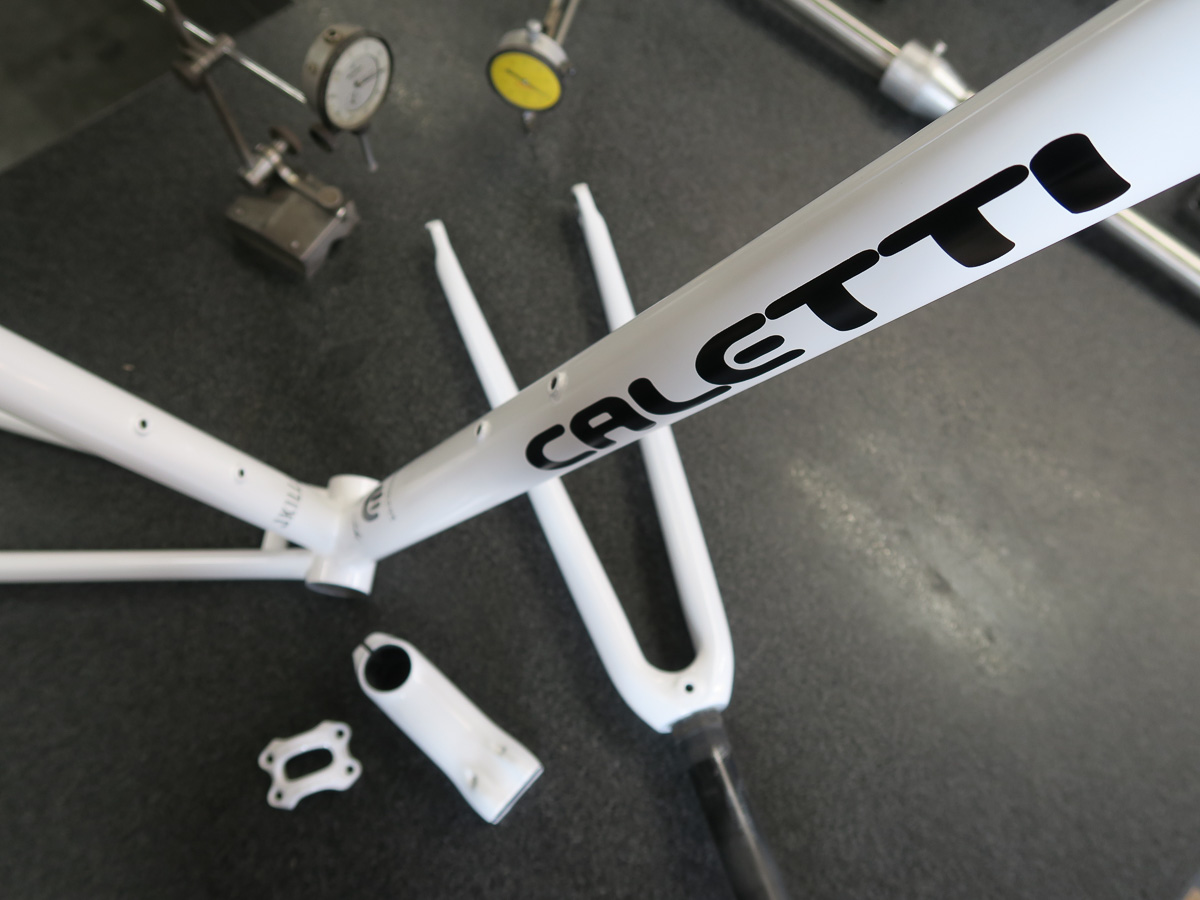
For John Caletti of Caletti Cycles, the ride of the bike is what it’s all about. Tradeshows and interviews about origin stories (like this one) are frustrating to him for this reason: they speak to the persona of the builder and the look of the bike rather than what the machine accomplishes in motion. This emphasis is reflected in the form and presentation of his frames. The aesthetic is clean. Curves, when they occur, are subtle. There is a constant distilling process occurringg at Caletti Cycles with respect to production procedure and formal presentation in order to enhance the frames intrinsic value of the frame.
In this phone interview, John discusses his course to becoming a frame builder as well as the significance of refinement within his product and operations.
And, for those fun loving folks out there, he gives us a sneak peek at the Scrambler, a new model to be launched at, and available to take home from, NAHBS.
BIKERUMOR: How did you get your start as a frame builder?
JOHN: My Dad is a mechanical engineer, but he really just built and fixed stuff all the time and had a ton of tools. I got into bikes and I’d be like, “Oh I need this, this thing is broken, I need to fix it. I need the tool for this. I don’t have it.”
“Well, what’s the tool look like? Well, let’s make it.”
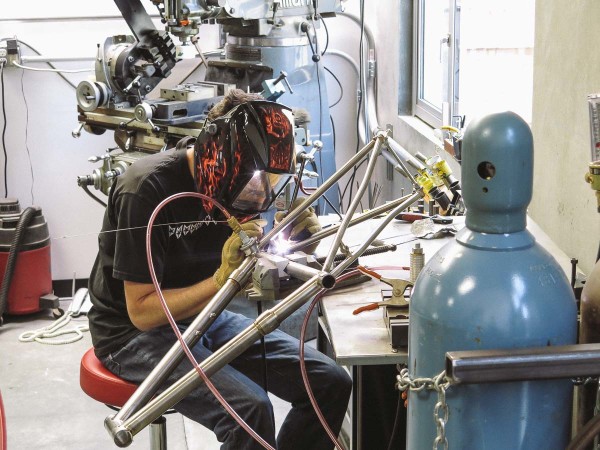
And we’d make some tool. And I was just kind of like, you know, that’s crazy. That was just kind of his attitude, like, make it, build it, fix it and I just had a tremendous opportunity being in a place where he was wanting to show me this stuff. It was all kinds of tools, including a lathe and a milling machine and an oxy acetylene torch and an arc welder- that tended to be my favorite stuff to do. I was just kind of blown away by working with metal and just loved that stuff. So I’d try to think of little reasons to make some little thing and go out there and work on that stuff.
Then I got into cycling and just kind of got into it more and more as part of a way of just being outside and adventuring and stuff. I’d kind of been backpacking and was kind of getting into rock climbing and mountain biking was a good extension of that.
BIKERUMOR: So when did you put together that you could tinker with your bike as a machine. For me, it was a really long time. Like, I like making stuff. And I like bikes. Then, oh my god! They can be the same thing!
JOHN: My Dad would fix the family bikes. He was never like into bikes in a big way, but he was into fixing things. So inevitably, in a big family, there’s like a bunch of bikes and they are kind of old, and so they need some repair. But when I started mountain biking, I started breaking stuff. My wheel’s all wonky, how do I fix it? He’s like, “Oh, here’s how you kind of do it.”So I’d start truing wheels and I was terrible at it, but it just kind of got me in there and do stuff. My friend and I would do these dumb things on our mountain bikes, like ride through a creek full of water, then “Our bikes are basically destroyed. Let’s pull every piece off the bike that we can possibly pull off of it and overhaul all the bearings and replace stuff.” For whatever reason, I wasn’t afraid of ripping the whole thing apart. I figured, I’ll just figure out how it works and how it goes together, that was just the attitude that was mainly coming from my dad. Figure out how it works, take it apart, clean it up, put it back together.
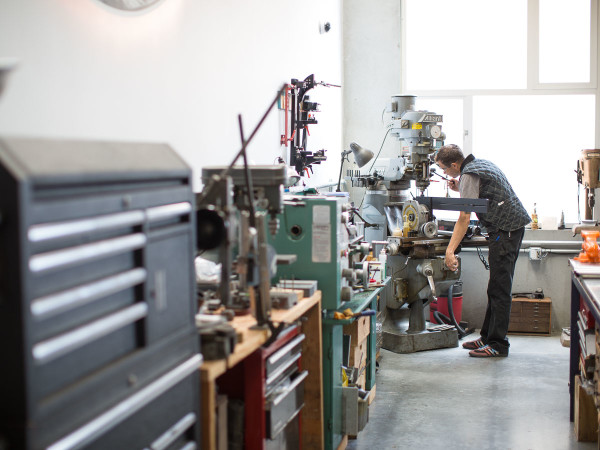
BIKERUMOR: That’s a very Montessori approach to bike education, you know? Like, how do you think this gets fixed? I can hear a bunch of company lawyers wincing at that.
JOHN: I wasn’t a great mechanic at that point. Which was great, because I’d get in over my head and learn something and learn it more and more. Of course it takes a long time working on bikes and later I was able to do it in a shop environment. I was into bikes for a long time, got more and more into it as time went on. Added road cycling and cyclocross to mountain biking. Doing all that stuff. And after I got out of college, I got a job in a bike shop. It was a really great bike shop and I learned a ton there. There were a lot of really smart, seasoned people in the shop…
BIKERUMOR: Which shop was it?
JOHN: Wheelsmith in Palo Alto.
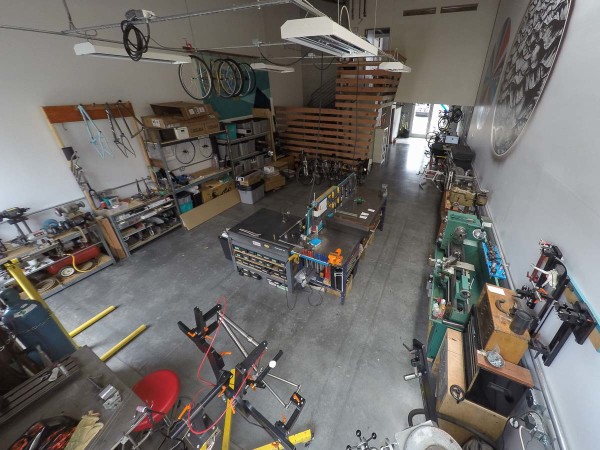
BIKERUMOR: That is an awesome shop.
JOHN: It was super cool. The owner, he’d been there for ages, started the place. Their whole spoke thing and their wheel building thing, was really amazing at the time. There’s just a lot of really smart people there, like, people who had been mechanics for Olympians and people who had been a photographer for the Tour and is a mechanic and also does Neutral Support for Mavic. Other guys that had worked on pro teams and racers and all kinds of these interesting people.
BIKERUMOR: And they treated mechanics like professionals.
JOHN: You know, a pretty serious environment. The mechanics had to be good there because they were paid flat rates rather than hourly rates. The standards were really high and the mechanics were really good. I was working in sales at the time, but that was kind of cool because I learned a lot of stuff about fitting people on bikes. Then started to sell custom bikes and fit people to custom bikes and that was super exciting and just really eye-opening for me.
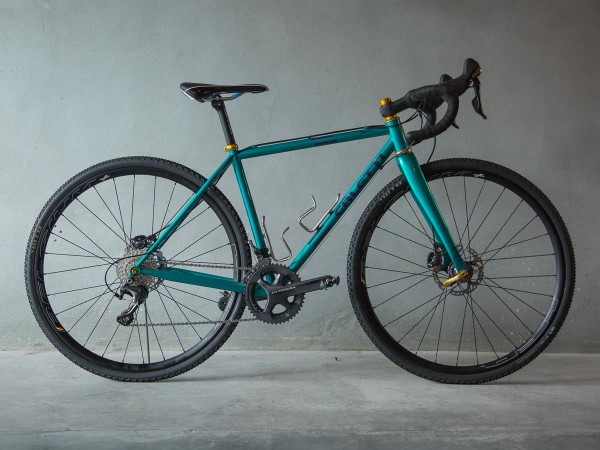
My proportions are a little outside the norm, so my first road bike was a really, like, bad fit. When I got onto a custom bike, it was amazing. It was more comfortable, it worked better, it descended better. It just felt right in a way that the other bikes just never could. So it’s cool to be in a position to kind of help people get into those kinds of bikes at the shop and I learned a ton about fitting. Later, moving back to Santa Cruz, I got a job at a different shop and was a mechanic there for awhile and moved to another shop in town, mechanic there as well… so that was a great avenue to kind of build up those skills.
Then I was familiar with the idea of custom frame building and that there’s people doing that and thought it sounded super cool, so finally I was like, I’m not thinking about it, I need to learn more about this. I was looking at the UBI course, but they were full way out, so I contacted Jim Kish and he was down in San Luis Obispo at the time. So I went and worked with him and did a more intensive long course. Then, coming back to Santa Cruz, I, for a while, rented some time at Rick Hunter’s workshop and made a couple frames there so I could use his tools.
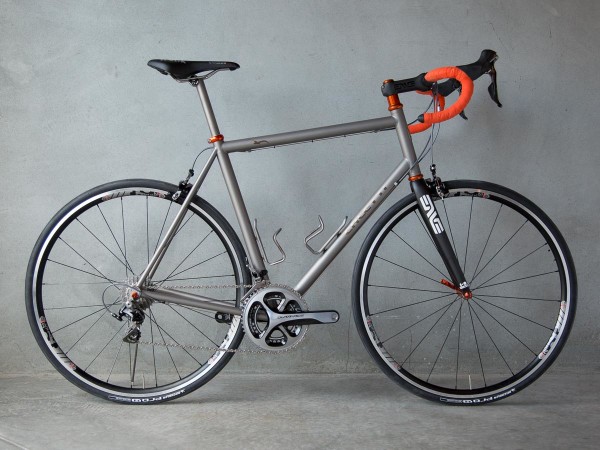
BIKERUMOR: Oh Awesome. Was it at his mountaintop hideout?
JOHN: No, this was prior to that. This was down in Watsonville. He had this huge warehouse space. He had a halfpipe in there, couple cars. Some other guys making BMX bikes were in there, you know, his whole collection of multiple lathes and milling machines and stuff. It was just this huge shop that was really kind of out of the way.
That was a cool experience because it’s like, I could learn. Like, “Rick, what do I do here? I’m lost, or how do you do this? How do YOU do this? Jim did it this way, what’s your way to do it?” Because everybody has their own system based on their tools and so forth. Anyhow, got to make some frames there and learn some stuff from Rick. Learned a few tricks from Paul Sadoff. Learned stuff online and kind of started connecting with other builders because at this point, I was like, I’ve gotta do more, this is super cool. So I was like making bikes for my wife and making bikes for myself. And making bikes for my friends.
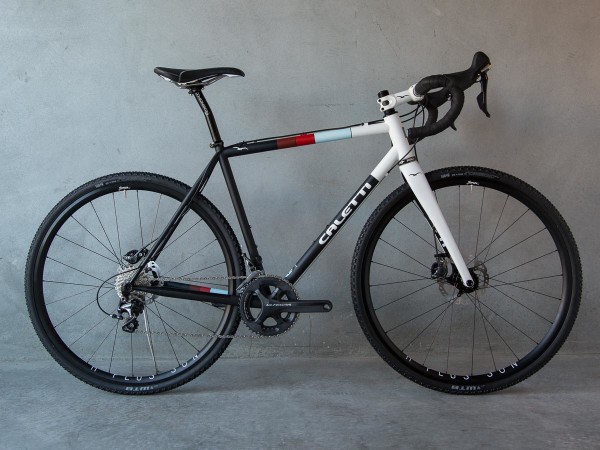
BIKERUMOR: So you weren’t your own brand, you were just working with other people.
JOHN: Yeah, initially I was just making some frames, and then I decided to get some tools. Once I had a frame fixture, it’s like, I tooled up pretty soon because I just knew I wanted to have this stuff. If I wasn’t building bikes, I would still have a lathe and a mill and a welder for some reason because I love that stuff. I got enough tooling that I could do stuff on my own. Anyhow, after a while, I started doing it for other people and selling bikes. I was scaling back my time working at the bike shop as I had more bikes to make for people, and kind of grew that way. I probably made my first frame 12-13 years ago, but I think of this as if I’ve been doing this for about ten years.
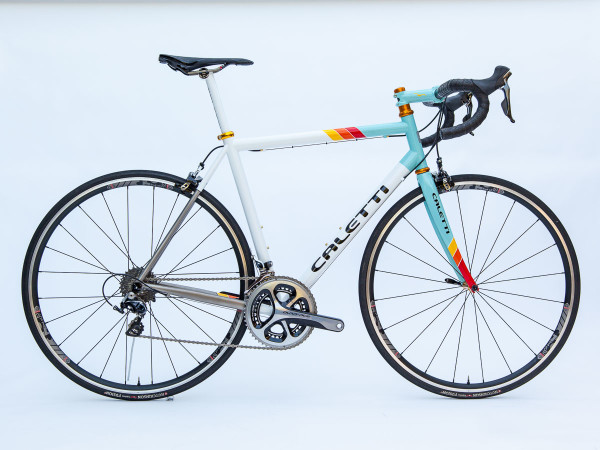
BIKE RUMOR: You benefitted from these other builders taking you in and working with you and giving you all this advice. Have you turned around and done this for other people? Do you take in lost children?
JOHN: Also along those lines, I have to mention Carl Strong. I think more recently, he’s been very helpful recently in terms of paying attention to the business stuff. He’s been a really great resource for me and a friend. He’s a super great guy with a really sharp mind and a really great builder.
In a lot of ways it’s like, not so much yet. It’s something I would like to do and I think that I’ve been very influenced by Carl and his kind of attitude of, “Hey, let’s make the custom bike world a better place. Let’s help people do a better job at what they are doing.” Because you want people to make good products that really are high quality and work well and are durable, and you also need to be able to do that in a way that is profitable so you can KEEP doing it. So you can get good at it. If you are really slow, and you can’t survive doing it, then you’re gone, right? That’s the problem, right? It would be fascinating to know who exhibited as a new builder every year at NAHBS and look and see how long everybody lasted because it’s tough to make it.
BIKERUMOR: It is! I don’t want to do that project because I think it would be really sad.
JOHN: No, we don’t. Okay, not everyone is going to make it. Probably not that many will make it. It’s a tough thing to do and make money at. So you have to be fast enough, smart enough, efficient enough, know enough little basic business things so you can survive and keep going so you that you can make a whole lot of frames – so you can be a really good builder.
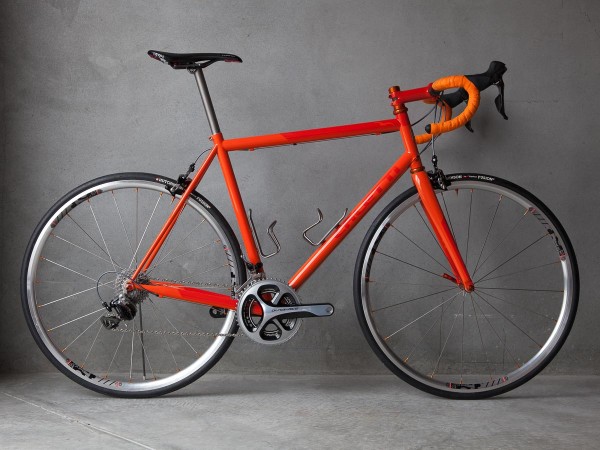
BIKERUMOR: Your impact is a lot bigger if you’re actually around to make it.
JOHN: Right. Right. And it kind of takes being around for awhile to be good, you know? I’m doing a better job now than I did eight years ago because I’ve made a lot of bikes and learned a lot of stuff by doing so, so in that regard, I think it kind of makes me feel like there is so much for me to learn. I’m always kind of refining and learning these things… it seems a little, I don’t know, daunting. I guess it seems a little daunting.
I don’t know – thinking about like I’m some seasoned guy, I don’t really have that mentality, but it’s something that I think is worthwhile. I’m very open in terms of sharing knowledge with other people. To some extent, I think it makes more sense to do it with people who have some kind of investment, like, “Look, I want to do this as a job.” Alright, cool, you need to be able to do this well and efficiently. It’s different than, like, “I can spend 50 hours making this frame and I’m the only one riding it so it doesn’t need to be perfect.” That person isn’t in need of much.
I have someone who is now an employee of mine who had been doing kind of a work trade with me where he would come in and do a few things for me, and I would teach him some stuff. He learned a lot about how to run a lathe and a mill. He was taking some welding courses as well. He’s built a couple frames of his own. Now, it’s great. He helps me do some frame prep stuff, and packing frames to go to Spectrum and back. He’s a mechanic, so assemblies and things. So that’s been a cool relationship.
BIKERUMOR: Has it been a positive thing for you? It sounds like you’ve made it into a productive part of your operation.
JOHN: Yeah, he’s basically tooled up enough himself that he can do a lot of stuff on his own. Some things, not. And I think he’s got a lot going on so he’s not trying to do a lot of that. But it’s been really cool to see how much he’s learned, thinking back to when he started to now. He didn’t know what a lathe and a milling machine was, and now he’ll go, “Hey, I need this tool.” And he’ll go make it. He’s very comfortable with that stuff.
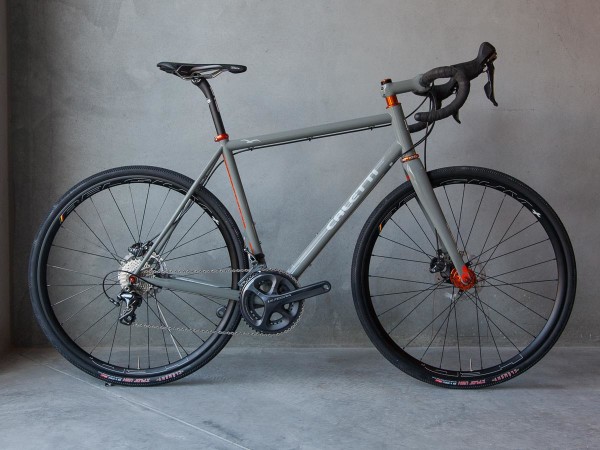
BIKERUMOR: Sort of in that vein, and you kind of touched on the idea earlier, but you talk about how much you personally learned in the past ten years. How has your product changed or your approach changed?
JOHN: I don’t think it’s changed drastically. I think it’s more like a refinement. My style, I want it to be sort of a clean, purposeful design. Emphasis on the ride of the bike. It’s great that they look good, but I want to do that in a way that is more like removing unnecessary things, keeping it really clean looking and the proportions balanced- the subtleties. How can I do the best job I can in terms of like getting better at all the things I do, whether it’s being more efficient with my time, or making the welds look a little bit better, or improving my process a bit so it produces better results.
And then, there are a few things like, oh- don’t do these things because it’s just a money loser, or figuring out to use Quickbooks better. How to understand that stuff and how to run the business. How to manage time so that I can get everything done that I need to. Stuff that’s not as exciting. I would say that the overall theme is just refining… making small improvements all the way around.
BIKERUMOR: So what are you bringing to the show? What’s the cool new stuff?
JOHN: Oh lots of good stuff. Because we’re in California and we can drive there, we went big and got a larger sized booth so we’d have a little more room and bring a few more bikes. Gonna have a titanium Adventure Road Bike, and that’ll be with newer parts, so an ENVE gravel road disc brake fork, flat mount style disc brakes. That’ll be a fun bike and pretty representative of what I’ll be doing a lot of upcoming. And then, I’ll have a titanium mountain bike with some new kind of geometry tweaks and parts planned to make it a really versatile bike. So I’ll bring one of those. And then we’ll have a single speed cross bike at the ENVE booth and other Ti mountain bike at the Shimano booth.
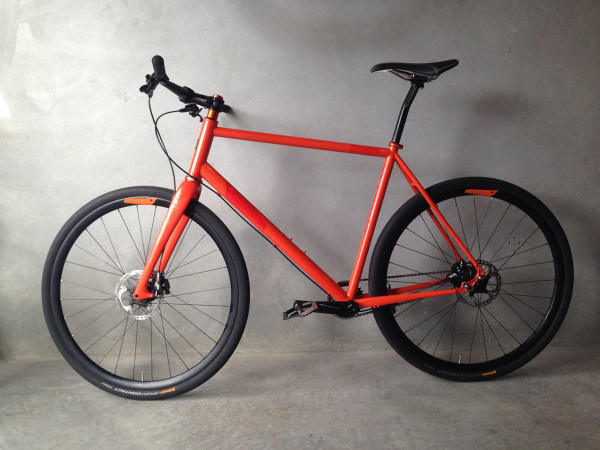
We’ll also have a new bike project called The Scrambler. It’s four sizes, one color- it’s a complete bike. And I should have probably three of them complete and ready to go and can be bought at the show.
BIKERUMOR: Oh cool!
JOHN: Yeah! So it’s a different thing that I’ve done in the past. I haven’t done it this way but I’ve been kind of kicking this bike around in my head and refining the design of it for years now, and just really wanting to do it, so it’s like well, I’m going to make some. And then we’ll see what people think.
BIKERUMOR: Is this a pseudo-production kind of program?
JOHN: It’s hard to know. Not exactly. I mean, to some extent it’s hard to know what to name it. I think that ultimately because we have all our regular customer bikes to make that it will be something like once a year, we’ll set aside a slot to build four or five of them or something like that, to build a small number. But the idea is that because it’s a stock size and a set build kit and stuff. The whole vision gets represented in the bike and everything works well together. And it reduces some of our time spent with the customer deliberating about parts and doing estimates and all that kind of work that can be a lot of time, so you know to some extent that if I can say, that time it shows up as a little less cost to the customer in their bike, but mostly it was just that it was a cool bike, I want to make this thing and this is a good way to do it that makes it accessible to people.
BIKERUMOR: So what exactly is the bike?
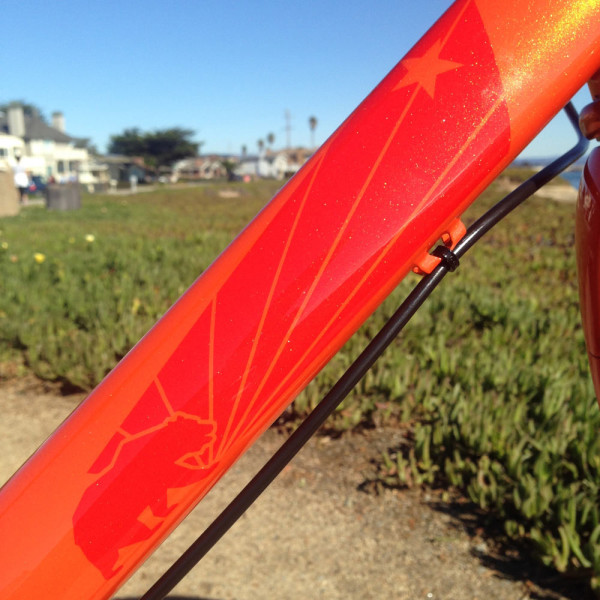
JOHN: It’s kind of an urban fun bike. Flat bars basically, 700 by wide tires, single speed, although you could set it up with an internally geared hub or a 1×11 system if you want, disc brakes, it’s got thru axles. It uses an ENVE cross fork. It’s bright orange with a cool graphic we designed with the bear from the California flag, and sort of a sunset-inspired pattern.
That’s basically the gist of it.
BIKERUMOR: That sounds fun.
JOHN: Yeah! It’s a super fun bike.
BIKERUMOR: I like the shift for some builders back towards just fun, nice bikes. Like, it makes sense and makes me happy. Nice bikes built for the joy of riding bikes.
JOHN: I think it’ll be a fun bike. I’ve had something sort of like this that I made for myself in the past. Initially, it was sort of, it’s kind of a fancy bike to ride around town. But then I ended up using the thing all the time, totally enjoyed it, it was super fun. That’s my hope with this, that this is going to be something that’s just really fun for people, that encourages us to get on our bikes a little more often. So we’ll probably bring three of those. They’ll be available for sale at the show if someone wants to get one. That’d be cool and it would make it easier for us to get home again.
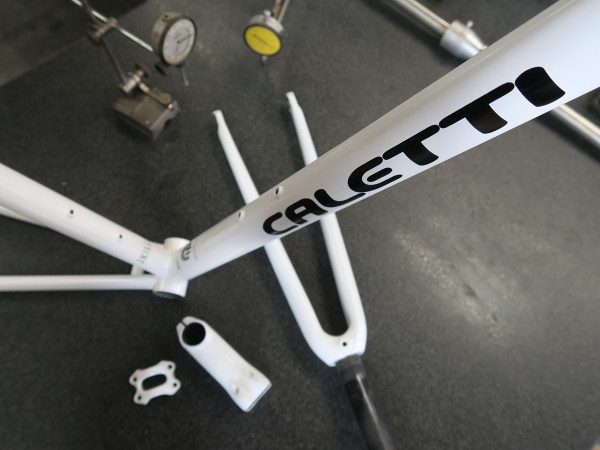
And then the last couple that we’re going to do is a model I call the Road Race Special. It’s a steel bike that’s a road racer that uses a cool mix of tubing, some neat shapes, light, very solid platform, kind of stiff. And we’ve had some special finishes on them. One is this rock and roll inspired bike that has lyrics subtly put into the finish of the frame. The other one is going to be hand-painted by an artist who is a friend of ours, Jeremiah Kille. He’s on our cyclocross team and – I’ve made him a few bikes and he’s a good friend and an amazing artist. He did some murals in our shop. We’ve been collaborating on some stuff for awhile on the cross team and other projects. So this bike, we have a Road Race Special. We got it powder coated and painted white with some simple black logos by Spectrum, and Jeremiah’s hand-painting the frame, the fork and the stem. We have some matching Giro Empire shoes painted, a helmet… it kind of got big. I think it’ll be really cool because his art is really amazing and it’s fun to see on a bike.
BIKERUMOR: You did a Grinduro bike, right? It was in the Giro booth at Interbike.
JOHN: Yeah, I think they brought it to Interbike. For this one, we just got some white shoes and Jeremiah painted them so they’re totally unique, but yeah, we have a lot of friends up there at Giro. They’re nearby and we ride with some of those guys. They are great folks so it’s been fun to collaborate on a few things.
BIKERUMOR: We’ve covered a lot…
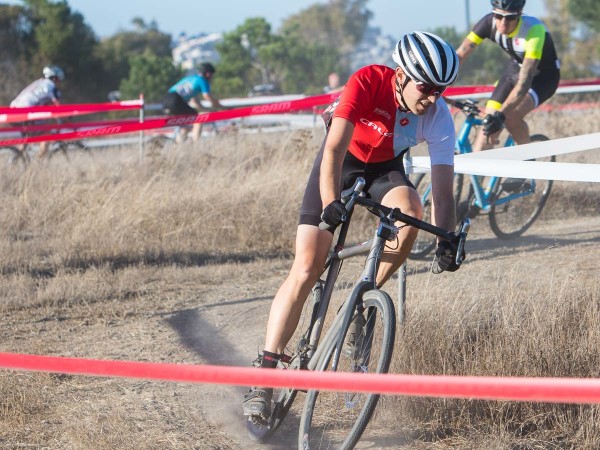
JOHN: I think it’s worth noting bike riding… because that’s what’s it’s all about! Basically, I ride bikes… often. Lots of different types, and I think it’s great because it helps kind of keep my head screwed on straight and it gives me a good way to test stuff out. “What would be better here?” and, “What if I did this and what if I did that…” and then I can build it and ride it and try it.
I just try to really stay connected to the sport and the lifestyle and the people that do it. The customers. And I think that that’s a good thing. It’s good for me, personally. As someone looking for a builder, I think that that’s kind of worth noting, I think that you really want someone that “gets it” in that way.
BIKERUMOR: So if people want to ride with John Caletti, what’s the program there?
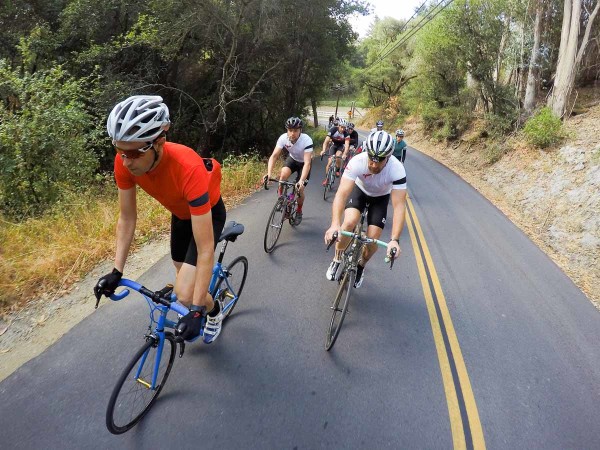
JOHN: We’ve posted some Meet Your Maker rides. We’ll have a schedule of Meet Your Maker rides this coming year, we’ll be at a few of those. That’s probably the most accessible thing that somebody would be like, here’s the route, here’s the date… you usually get a lot of builders coming out and you can hang out and talk to or ask questions or see their bikes, or other people who have the bikes are out riding as well. So it’s kind of a fun thing. So we’ll do that.
BIKERUMOR: So given the personalities at the show, there’s bound to be someone that wants to be the next John Caletti. What advice do you give that kid?
JOHN: Oh man. That’s a huge question. It’s hard to know exactly what to say. I guess it’s like, usually people that have that orientation are already excited about making stuff.
BIKERUMOR: “That orientation!” Ha!
“What’s your orientation?”
“John Caletti.”
JOHN: You know what I mean. Someone who is maybe a little more mechanically inclined. Some people gravitate towards that or some people don’t. You’re not going to get someone asking you, like, oh I want to do that, that’s great, if they never pick up a tool. They are probably already into that. I think the advice part would be- if you want to do it for a job, you have to be able to generate an income. You have to figure out a way to make it work. A lot of ways to do it are complicated, but you have to think about that part.
